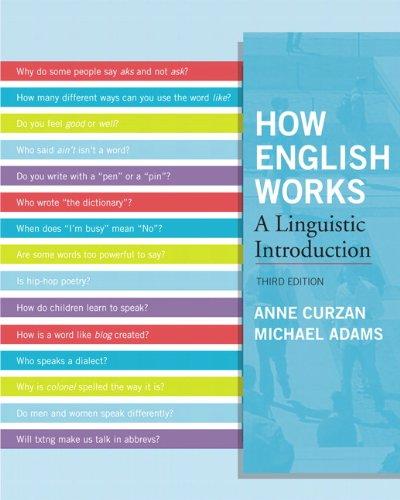How English Works: A Linguistic Introduction (3rd Edition), Paperback, 3 Edition by Curzan, Anne
Paperback: 3 Edition
9780205032280
0205032281
Publication Date: 2011-02-05
Publisher: Pearson
Paperback : 576 pages
Edition: 3 Edition
Author: Curzan, Anne
ISBN-10: 0205032281
ISBN-13: 9780205032280
Product Description A major introductory language/linguistics textbook written specifically for English and Education majors, this book is an engaging introduction to the structure of English, general theories in linguistics, and important issues in sociolinguistics.¿ ¿ This accessible text provides more extensive coverage of issues of particular interest to English and Education majors.¿ Tapping into our natural curiosity about language, it invites all students to connect academic linguistics to everyday use of the English language and to become active participants in the construction of linguistic knowledge. ¿ The second edition provides updated examples of language change—including new slang and other word coinages, grammatical developments, and sound changes—as well as new research findings on American dialects, language acquisition, language evolution, eggcorns, English and the Internet, and much more. From the Back Cover On the cover of this book, you’ll find many questions that you may have asked and wondered about the answers. How English Works addresses those questions while it introduces you to the structure of English, general theories in linguistics, and important issues in sociolinguistics. As an English or Education major, or as a student taking the course because the study of linguistics is of interest, you will connect academic linguistics to the everyday use of the English language around you. The English language is always changing, which leads to new insights about how language, and the English language specifically, works. The authors revised this textbook to keep up both with linguistic scholarship and with the language itself. New to This Edition: · New and updated material on electronically-mediated communication such as texting and the etiquette of instant messaging. · A major new section on literature and linguistics with tools for reading and analyzing literary works in relation to speech acts. · A new explanation of where (some) contractions, like I’ll, fit into English word formation 4 · · An improved section on “what makes good writing.” About the Author Anne Curzan is Associate Professor of English at the University of Michigan, where she also holds an appointment in the Department of Linguistics and School of Education. In 2007, she received an Arthur F. Thurnau Professorship for outstanding contributions to undergraduate education. She is the author of Gender Shifts in the History of English (Cambridge UP, 2003) and co-author of First Day to Final Grade: A Graduate Student’s Guide to Teaching (U of Michigan P, 2006). She currently serves as co-editor of the Journal of English Linguistics. Michael Adams teaches English language and literature at Indiana University, Bloomington. For fifteen years, he taught at Albright College, in Reading, Pennsylvania, where he also served as chair of the Department of English and associate academic dean; he has been a visiting professor at Duke University, North Carolina State University, and the University of Iceland. He is the author of Slayer Slang: A Buffy the Vampire Slayer Lexicon (Oxford UP, 2003) and Slang: The People’s Poetry (Oxford UP, 2009), as well as contributing editor to Word Histories and Mysteries: Abracadabra to Zeus (Houghton Mifflin, 2004). He was editor of Dictionaries: Journal of the Dictionary Society of North America for several years; currently, he is editor of the quarterly journal American Speech.
Books >> Subjects >> Literature & Fiction >> History & Criticism >> Movements & Periods

